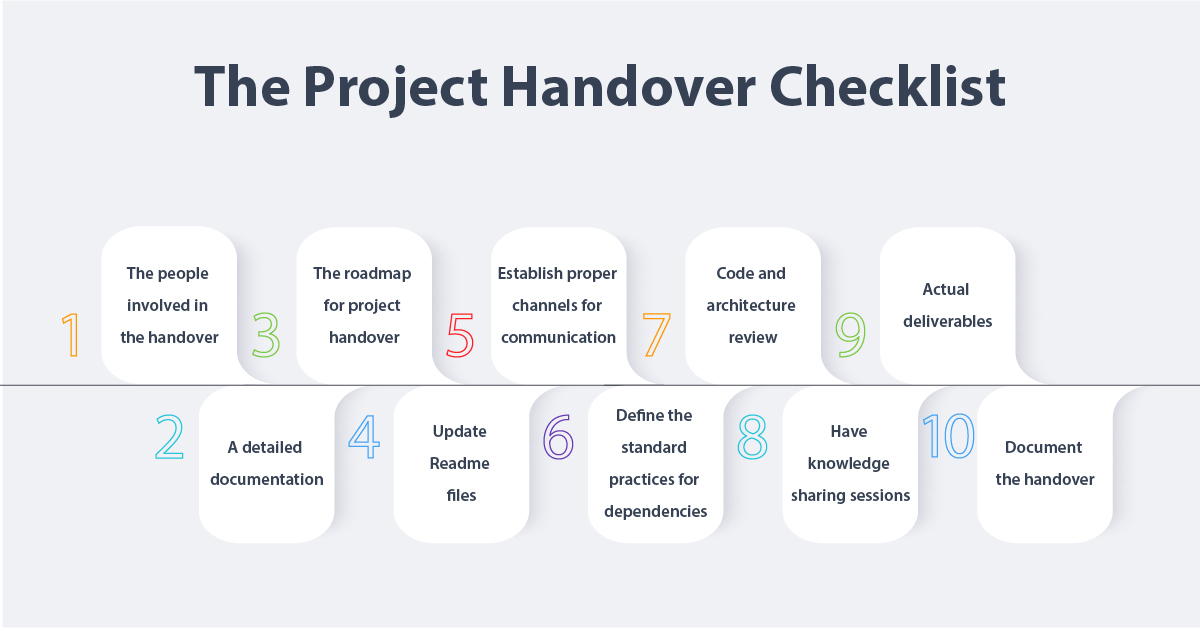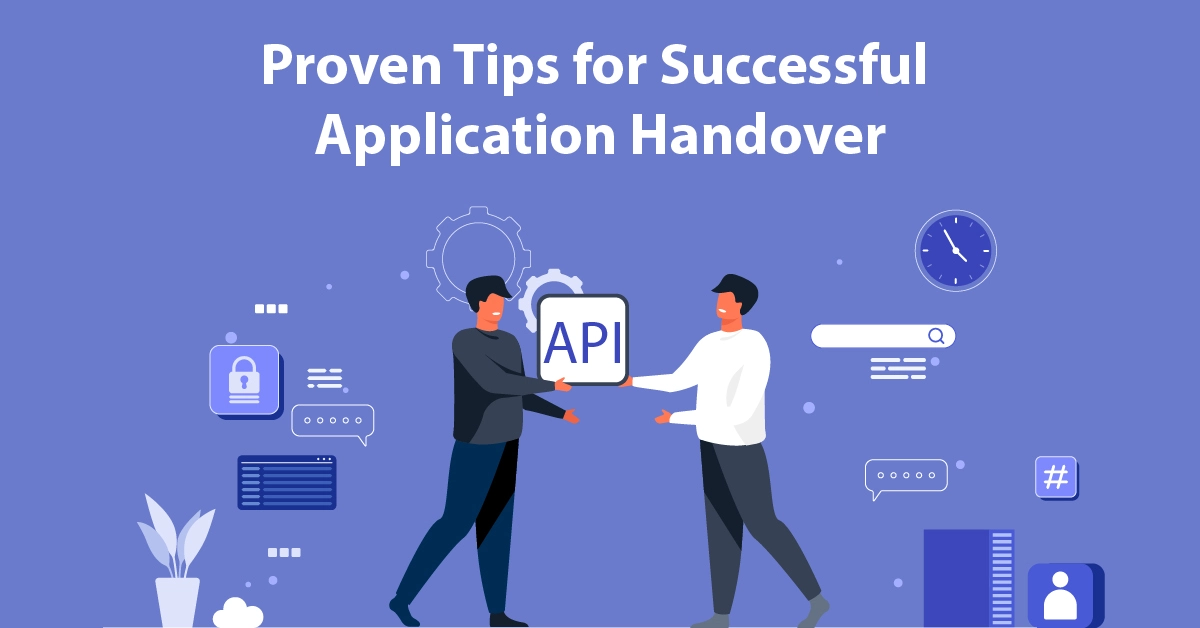Top 10 Proven Checklist for Successful Mobile App Handover
Project handovers are crucial for any business, especially when the project moves from the development phase to the business phase. The developer's work ends with the handover, while your job of using the product begins.
Once the handover is complete, your in-house team will be responsible for regular maintenance and immediate support. Without the application handover checklist, this process can undergo several problems, leading to chaos post-handover.
Despite having the best support team, you will realize that you haven't understood the project entirely or are facing some troubles using the application.
We have curated some of the top things that you should necessarily include in your handover checklist to make sure it is smooth and seamless.
 A checklist can come in handy when you are planning the project transfer. It will ensure you have considered everything that needs to be transferred before moving ahead with the process.
A checklist can come in handy when you are planning the project transfer. It will ensure you have considered everything that needs to be transferred before moving ahead with the process.
#1. The people involved in the handover
It would help if you listed out all the people who will be part of the handover process. For example, do you need everyone from the business team? Will the CEO of the company be involved in the meeting?
Who will be concerned with managing the code? Who will be responsible for explaining the code? These few questions will help you get the right people aboard.
It is essential to think through the people, as involving everyone may not lengthen the process or lead to more chaos.
#2. The Roadmap for Project Handover
Whether development or handover, knowing what to expect makes things easier. Try and create the roadmap for the transfer. This roadmap will mention how you aim to process the transfer. For example, if you have added three key people from your team, note the roles and responsibilities at this stage.
Use the roadmap to identify possible risks involved in the transfer. Identify how you plan to execute the transfer. Planning is key to ensuring seamless transfers for your code.
#3. Introduce the Project
Several stakeholders involved in the project transfer may not be aware of the project or the code. They would be completely new additions to this project. You may want to tell them about the project before handing over the code and other details.
You have assigned the roles and responsibilities; it is time to ask them about the development process, how they coded and what methods they used. It is an excellent way to set the stage before moving forward.
#4. Detailed Documentation
We always suggest documenting every bit of the work done during development. You may miss out on a few things while transferring, but the documentation won't.
The documentation should consist of the release phases, include the code with comments, mention the need for the different screens, and be updated on navigation.
There should be a complete note on every part of the project, from start to end, including the kickoff meetings. It would help establish the background, the vision when developing and why you added particular features.
- User support documentation that helps the user with troubleshooting steps and debugging methods
- QA workflow documentation
- The technical documentation
- Code related documentation, source code procedures, coding standards, and other developer documents
#5. Update the Readme File
This should contain all the relevant information for knowledge transfer. It should help the new team take over from there in a way that they can build the project from there.
The file should include the steps to set up the project and detailed information on how you can run the project locally. It should have API integration information, complete API documentation, and steps to send the app for deployment.
It should be complete with all the information that the developer will need to use, integrate, plug-n-play, and deploy to the store. It will help the internal developers maintain, support, and upgrade the app to meet the new requirements.
#6. Proper Communication Channels
Communication is key to transferring knowledge. In the case of a remote working environment, it is essential to choose the proper channels to communicate with the businesses to share the code and project.
You can have a recorded meeting virtually with all the people involved to set the pace for the transfer. Identify the knowledge-sharing sessions needed and how you would like to approach them. Some of the sessions would be in synchronous mode (virtual meetings), while you can carry out a few others async.
Apart from the meetings, you will need channels like project management software, async communication software (slack or WhatsApp), and others that can help you communicate and share the knowledge.
#7. Define the Dependencies
When communicating with a team with non-developers involved, you might want to review the dependencies and essential requirements to use the project.
Talk to them about the file formats, the system requirements, and other dependencies that will help them use the project.
It is essential to take them through the same using the documentation as mentioned earlier. However, it would help if you showed them these things while running the virtual meeting. It will help them identify the setup correctly.
#8. Code and architecture review
This is an essential part of knowledge transfer and should be done before handing it over. It will help mitigate the risks and ensure standard practices.
You should review the code and delete the unnecessary items before completing the process. You should write comments and lines to help the next developer identify with the code.
It would help if you connected with the team about the code and lines that are not very important and can be removed. Tell the group what is good code and what isn't. Show them the practice you have followed.
Make sure you have standardized the code format and included only lines relevant to the structure.
#9. The Actual Deliverables
Once you have identified everything else, here are the different deliverables you need to get for the transfer.
1. Ownership Transfer: Whatever accounts are being used are being handled by the development team. You should get the complete transfer of the project at your end. The local and project stage should be with your development team.
2. Access to Accounts: Everything that has been used for development should be in your business name now. Get a complete transfer of all the demo accounts, online accounts including AWS, email marketing tools, and other website-related details. This will ensure you have everything under your control.
If two people manage the same account, it can cause chaos.
1. Version History: The developer team needs to share the entire version history with you. They should detail all the versions that the app went through during development, along with the bugs they fixed. This would help you know how and what led to this app, and you can build on it.
2. Codebase Transfer: It is essential to get the codebase (source code and other coding details) from the development team. As mentioned earlier, make sure they have reviewed the code. At this point, when the transfer is happening, you should also get your in-house team to review the code and get it checked.
#10. Document the Handover
It is important to email the complete handover process, mentioning all the things you transferred and the things that remain to be shared.
It would help if you mentioned everything with the dates so that it is documented and everyone is aware. Ensure to email this document to all the people involved in the handover.
Conclusion
Application handover checklist guides you towards planning the knowledge transfer and minimising the risks involved. It allows you to develop the roadmap, identify the stakeholders, prepare the base and determine the documentation for the project transfer.
It is essential to be clear about the transfer deliverables right from the start to plan your timelines accordingly. Please make the transfer in a phased manner.
If you have requirements related to mobile app development services, feel free to call us at +91 701 616 6822 or send us an email at [email protected] to get started on your app development project.
 Jignen Pandya
Jignen Pandya





